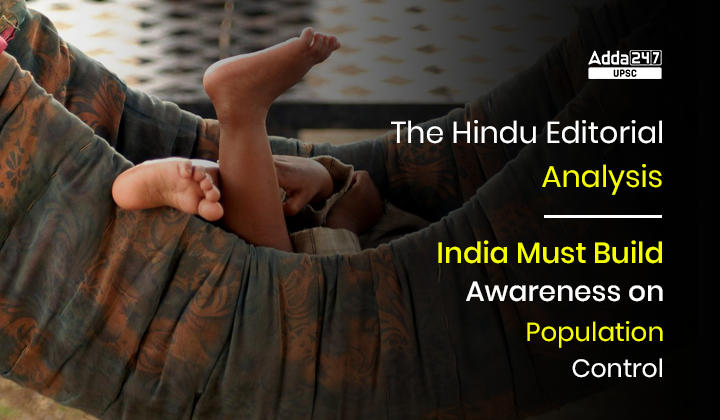Table of Contents
Awareness on Population Control in News
- Early in December, two Members of Parliament introduced in the Lok Sabha a private members’ Bill aimed at population control in India.
- Stating that population rise is the most significant reason for India’s slow rate of development, the Bill argues for an immediate need for population control.
Background of Population Control Debate in India
- The debate and the discourse around India’s rising population is not recent, having begun since Independence.
- India was among the first nations to address its population problem as early as 1951, raising awareness about the ills of overpopulation.
- While there has been a significant rise in India’s population, there has also been a sharp decline in India’s total fertility rate (TFR).
- In 1950, the TFR was at around 5.9%, and is now 2% (fifth round of the National Family Health Survey, or NFHS).
- There was a steep decline after the 1970s, indicating an inversely proportional relationship between economic prosperity and the fertility rate.
National Population Policy 2000
UP Population Bill- A politicised debate
- The debate around the need for population control has been greatly politicised in India.
- The entirety of this discourse around such a sensitive issue is often reduced to a petty religious issue, and, ultimately, the subject of development suffers.
- Nearly six months before the 2022 Uttar Pradesh Assembly elections, the Yogi Adityanath government and the State Law Commission of Uttar Pradesh came up with a proposed draft Bill, i.e., the Uttar Pradesh Population (Control, Stabilisation and Welfare) Bill, 2021.
- Population is a grave concern in the Hindi heartland, especially Uttar Pradesh and Bihar, but the suggestions were more political than practical.
- The visible attempt was towards an affirmation of the majoritarian politics being played out.
- For instance, the Bill said that no government job would be offered to couples with more than two children.
- However, there was no clarification about what would happen to a person who had a third child after being in a government job or if, for some reason, a person with two children remarried and had a third child.
- The Bill was seen to strengthen political polarisation and facilitate the politics of majority appeasement.
The Editorial Analysis- Moving Policy Away From Population Control
Is Population Growth Really an Issue?
- NFHS data indicate that although the fertility rate of Muslims is higher than Hindus, the gap between the two has shrunk substantially.
- In 1992-93, the gap between the Hindu and Muslim fertility rate was 1.1, which now has reduced to 0.35. A close comparison of Census data on average fertility rates is insightful.
- For instance, in Uttar Pradesh, with around 20% Muslim population, the TFR declined from 5.8% in 1981 to 2.7% in 2011.
- In Assam, where the Muslim population is about 33%, the TFR is 1.9%. Similarly, in Jammu and Kashmir, where the Muslim population is the majority, the TFR fell from 4.5% in 1981 to 1.4% in 2011.
- Data also show that Muslims have adopted better family planning measures than Hindus.
- India’s TFR, 2%, is even lower than the replacement level, signifying a remarkable step in the population control parameters.
- It is clear that India does not need a law for forced population control.
UN Population Report 2022
Impact of Forced Population Control Measures- A Case Study of China
- External Affairs Minister S. Jaishankar too has countered the need for such a law by saying, “forced population control can have very dangerous consequences, it can create a gender imbalance”.
- Forced population control measures have not shown promising results in the countries that have implemented them, the most relevant example being India’s immediate neighbour, China.
- The one-child policy has proved to be disastrous, causing a demographic imbalance.
- The population of China is aging faster than in any other modern country, owing to the policies of forced population control.
Way Forward- Strengthen the health infrastructure
- India needs to adopt population control measures. But the focus should be on strengthening public health infrastructure and raising awareness about the need for population control.
- Any forced control method will impact the rate of aging. United Nations data show that there is a projected rise in the population of older people and a decline in the young population in many countries.
- Although the trend started in rich countries such as Japan, the trend is now visible in developing countries as well, especially Southeast Asia.
- Among these trends, implementing forced population control can only have negative consequences.
The Editorial Analysis: Does India Need a Population Policy?
The Editorial Analysis: Does India Need a Population Policy?




 TSPSC Group 1 Question Paper 2024, Downl...
TSPSC Group 1 Question Paper 2024, Downl...
 TSPSC Group 1 Answer key 2024 Out, Downl...
TSPSC Group 1 Answer key 2024 Out, Downl...
 UPSC Prelims 2024 Question Paper, Downlo...
UPSC Prelims 2024 Question Paper, Downlo...
